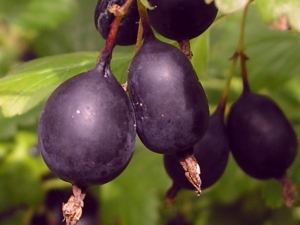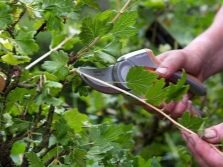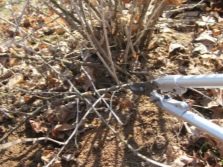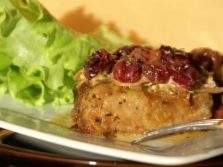Characteristics, cultivation and use of gooseberry "Black Negus"

Of the many varieties of gooseberry stand out "Black Negus".It possesses good productivity, pleases gardeners with neat beautiful fruits with bright taste, is not afraid of colds and most diseases. However, sharp thorns greatly complicate the process of care for the culture.
Variety description
Gooseberry, which is called “Black Negus”, refers to a variety with spikes, bred by crossing. Its striking feature is resistance to numerous diseases, which arose due to breeding studies. Spreading shrub grows very powerful and tall, sometimes up to two meters. The leaves are medium with three or five blades. The stems of the plant are thick and dense, covered with long sharp spines. Reviews suggest that if Black Negus were without thorns, this variety would be considered almost perfect, but dangerous processes, sometimes even double or triple, spoil the whole picture.
The fruits do not have a smooth rounded shape, rather they resemble a small pear. The color of gooseberry is deep purple, almost black. Smooth skin without a gun is covered with a thin wax coating, and the size of the fruit itself barely reaches three centimeters in diameter. The taste of the berries is more sour than sweet, and the smell is rich and rather non-standard. The flesh is colored dark red and has small grains. The weight of one fruit is about two grams.
The yield of the berries is quite high and regular, which is largely due to the ability to withstand low temperatures. This also includes the sudden onset of spring frosts. This property of culture allows you to grow it in different climatic zones. The fruits begin to ripen in the middle of summer in the second year after planting, which makes it possible to classify the variety as mid-season. Flowering occurs in the second decade of May, and the fruits themselves can be collected until mid-August. Usually on one bush the gardener collects from eight to ten kilograms of fruit. The gooseberry uses are quite traditional - it is used for making jam and jam, compotes and sauces, in desserts and wines.
It should be mentioned decent keeping quality and ability to transport - "Black Negus" is not afraid of transportation, which lasts more than three weeks. In addition, the variety has innate immunity to fungi, powdery mildew and rust. Do not disturb the culture and insect pests. The berries do not crack due to excess moisture and practically do not crumble - they need to be collected independently. The main disadvantage of this variety is still called thorns in the internodes. They greatly complicate the process of care, and also do not allow to transform the bushes into a single hedge. Finally, it is important to mention that the gooseberry able to grow successfully in the same place for twenty years.
Useful properties and harm
In addition to traditional cooking, berries are used for medicinal purposes. It is believed that the fruits have a beneficial effect on the state of the heart system, help to cope with anemia, put in order metabolic processes and stimulate the bowels. In addition, gooseberry is an effective diuretic and choleretic agent, filled with vitamins and beneficial substances.
Possible uses include cosmetology. In addition to successfully combating post-acne, the berries help to remove freckles, heal wounds and nourish the skin and hair with nutrients. The harm of the gooseberry can be in the case when the product is consumed either by a person with individual intolerance, or else consumes the berries in excess. Since fruits have a laxative and diuretic effect, their excessive use can lead to unpleasant consequences.
Landing
The gooseberry does not impose special requirements on the state of the soil, but nevertheless one should avoid swampy or acidic areas. To prevent an unpleasant situation before planting, digging holes, you will need to make a mixture of humus and wood ash in them.Typically, both components are taken in an amount of from 200 to 250 g. In addition, a ready-made mineral fertilizer of 150 g is added. The chosen place should be well lit - this will contribute to the best taste characteristics of the variety.
Care
The main components of the care of the "Black Negus" are pruning and fertilizing. When the young bush enters the age period from two to seven years, characterized by low productivity, it is time to form. Then it will be necessary to cut the twigs to stimulate the active development of new shoots. In addition, in the first years it is imperative to shorten perennial branches and part of the root shoots. In the fourth year, it is important to prevent thickening of the landings - that is, remove all dried, outdated, diseased shoots, as well as those that grow somehow crooked. In the seventh year of existence, we can safely eliminate the six-year shoots, because after reaching this age, they will no longer actively bear fruit.
Usually, pruning is done either when the buds are blooming, or when all the leaves have already fallen. In addition, some experts prefer to cut off green shoots in the summer - it is believed that this will improve the yield. Foliar dressing should be carried out once a month while vegetation occurs. In the spring months, it is recommended to make either ammonium nitrate or urea under each bush. In the first case, 50 grams per plant is used, and in the second, 30 grams. By the way, urea itself can be dispersed in granular form, until the snow has melted - so melt water itself will deliver fertilizer to the roots. In the autumn months gooseberries require organic fertilizer.
Watering is carried out once every two weeks. Approximately 30 liters of liquid is spent on an adult gooseberry.
It is important not to overdo it with the amount of liquid, so as not to contribute to the formation of powdery mildew. Mulching is usually done in early June using peat or humus.
Breeding
The most convenient way to propagate "Black Negus" with the help of layering. To do this, in the spring, the chosen strong shoot bends down to the soil and is buried so that the groove reaches from six to eight centimeters. Having fixed the process, it will have to be poured and the top shortened by about a quarter. During the vegetative season, the cuttings will need to be watered periodically, and with the advent of shoots, they will also need to be fed with fertilizers. In the fall, the seedling can be separated and transplanted to a selected area.
Cooking recipes
From the gooseberry variety "Black Negus" you can prepare numerous desserts, dressings and blanks. For example, it is easy and quick to make berry confiture with apples. In addition to a kilogram of gooseberry, you will need only a pound of sour apples and 750 grams of sugar. The berries are peeled and washed, and the apples are peeled and cut into neat slices. Both components are ground in a blender, mixed and poured into a saucepan. Bringing the mass to a boil, you must add sugar and boil it still for five minutes. By removing the foam, the finished confiture can be decomposed into sterilized jars.
The simplest sweet dish is raw gooseberry jam. It is enough to take the fruits and sugar in a ratio of one to one. Everything is worked through in a blender until a uniform mass is formed, and then poured into hermetic containers. If citrus fruits are added to the same ingredients, the taste will become more piquant and unexpected. It will only be necessary to take a zest of two or three lemons or oranges and pass it through a meat grinder. All ingredients are mixed and laid out in banks. Keep the workpiece must be in the cold, for example, in the refrigerator.
An unexpected solution would be to pickle the Black Negus gooseberry.Of the ingredients, you will need 950 grams of berries, twelve leaves of currant or cherry, nine dill cloves, nine peas of pepper, a tablespoon of salt, three tablespoons of sugar, two teaspoons of seventy percent acetic acid. Peeled gooseberries are laid out in half-liter jars, then three sheets of each type are put in each, three peas and three peppers. Everything is filled with boiling water for five minutes, then the liquid is poured into a separate container. It consists of three currant leaves, and everything boils for another five minutes. After taking the leaves, the remaining liquid should be covered with sugar and salt, brought to a boil and mixed with vinegar essence. The gooseberry is poured over the renewed liquid, after the jars are ready for rolling.
Black Negus is used even for such complex dishes as baked pork. The list of ingredients includes 800 grams of meat, a couple of bulbs, 150 grams of walnuts, three cloves of garlic, 300 grams of gooseberry, zest and lemon juice, greens and cognac in the amount of 100 milliliters. The meat is cut into fragments of medium size and is filled with marinade for four hours. It is usually made from brandy and three tablespoons of lemon juice, but alcohol can be replaced with soy sauce. At this time, onion rings and finely chopped garlic are fried in a skillet, and then pork is processed in the same oil.
Following the above ingredients are transferred to the form, oiled, supplemented with fresh herbs, for example, mint and thyme, gooseberries, nuts, and dried grated. Of course, we must not forget the spices. The container is covered with foil folded in half and retracted into the oven, which must first be heated to 200 degrees. After thirty minutes, the foil can be removed and another quarter of an hour to keep the dish warm, already at a reduced temperature to 180 degrees.
Of course, black gooseberry jam is considered the most common. A kilogram of berries is supplemented with only 500 grams of sugar. Both ingredients (the berries should already be processed as desired) are ground in a blender, once again mixed by hand and laid out in sterilized containers.
Instead of sand, by the way, it is permissible to use honey - approximately 400 grams for the same amount of berries.
Review of the gooseberry "Black Negus", see the following video.
































